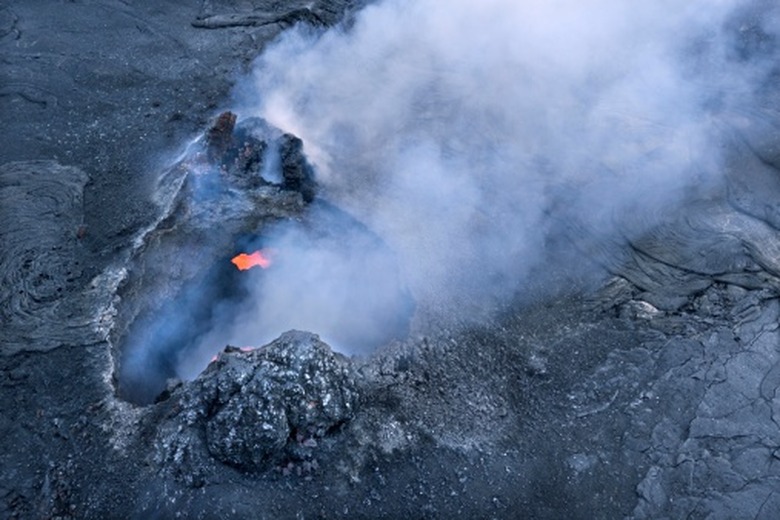Facts On & Causes Of Volcanoes
Each type of volcano has its own set of physical characteristics. Geological forces and conditions create each type. In 2008, scientists discovered an active volcano in western Antarctica. Dr. David Vaughn, one of the doctors reporting on it and completely shocked, said, "This is the first time we have seen a volcano beneath the ice sheet [where they found the volcanic ash and glass shards] punch a hole through the ice sheet."
Composite Volcano Facts
Composite Volcano Facts
Composite volcanoes, or strato volcanoes, reach heights of more than 10,000 feet and feature the iconic volcano shape, with steep, concave sides. Their eruptions are explosive and typically involve pyroclastic flows; eruptive columns; and lahars, or mudslides. Mount St. Helens and Mount Fuji are famous examples of composite volcanoes.
Composite Volcano Causes
Composite Volcano Causes
Composite volcanoes are typically found along tectonic subduction zones. Here, one plate is pushed beneath the other, causing it to melt. The resulting magma works its way to the surface, forming composite volcanoes. This process creates thick, explosive andesite and dacite lava.
Shield Volcano Facts
Shield Volcano Facts
Shield volcanoes are among the planet's largest volcanoes, with broad, gently sloping sides. Mauna Loa is the largest volcano on earth, with a volume of 19,000 cubic miles and a surface area of 2,035 square miles. Mauna Kea is the tallest volcano on earth, rising 13,796 feet above sea level, but an incredible 31,796 feet above the seafloor.
Shield Volcano Causes
Shield Volcano Causes
Volcanic hotspots and tectonic divergent boundaries create shield volcanoes. Hotspots represent thermal plumes of superheated magma under the earth's crust. An oceanic hotspot is responsible for forming the Hawaiian Islands. Divergent zones occur where plates are spreading apart. Basaltic lava pours into the resulting space, creating new crust. Shield volcanoes can also occasionally form in subduction zones.
Cinder Cone Volcano Facts
Cinder Cone Volcano Facts
Cinder cone volcanoes, also known as scoria cones, are the most basic type of volcano. They rarely rise higher than 1,000 feet and consist of a pile of lava rocks. Their eruptions fall somewhere between the lava flows of shield volcanoes and the explosive eruptions of composite volcanoes. Paricutin, located in Mexico, formed in a farmer's field and, during its nine years of eruptions, covered 100 square miles in ash and 10 square miles in lava flows.
Cinder Cone Volcano Causes
Cinder Cone Volcano Causes
Cinder cone volcanoes are found in almost all tectonic environments. They can occur on the sides of composite volcanoes and shield volcanoes, or on their own. Cinder cone volcanoes are found in hotspots, divergent zones and subduction zones. They typically have a small magma chamber. This chamber is not usually replenished, and they become dormant once it is emptied.
Caldera Volcano Facts
Caldera Volcano Facts
Caldera volcanoes are the most explosive of all volcanic eruptions, thus their nickname supervolcanoes. During the last eruption of the Yellowstone volcano, approximately 640,000 years ago, the volcano ejected 250 cubic miles of material, or 8,000 times that of the 1980 eruption of Mount St. Helens. And this was less than half the size of its eruption 2.1 million years ago.
Caldera Volcano Causes
Caldera Volcano Causes
Caldera volcanoes are the result of continental hotspots. Unlike the basaltic lava of their oceanic sisters, continental hotspots create rhyolitic lava. This lava has an extremely high concentration of trapped gasses, making it highly explosive.
Cite This Article
MLA
Bennett, Doug. "Facts On & Causes Of Volcanoes" sciencing.com, https://www.sciencing.com/causes-volcanoes-8639957/. 24 April 2017.
APA
Bennett, Doug. (2017, April 24). Facts On & Causes Of Volcanoes. sciencing.com. Retrieved from https://www.sciencing.com/causes-volcanoes-8639957/
Chicago
Bennett, Doug. Facts On & Causes Of Volcanoes last modified March 24, 2022. https://www.sciencing.com/causes-volcanoes-8639957/
